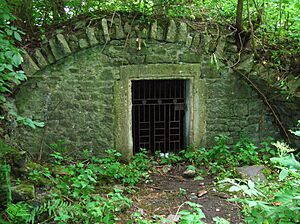Reed Loch facts for kids
Quick facts for kids Reed Loch |
|
|---|---|
| Lua error in Module:Location_map at line 420: attempt to index field 'wikibase' (a nil value). | |
| Location | Troon, South Ayrshire, Scotland |
| Type | Old freshwater loch |
| Primary inflows | Darley Burn, rainfall and natural drainage |
| Primary outflows | Darley Burn |
| Basin countries | Scotland |
| Average depth | Shallow |
| Settlements | Troon |
The Reed Loch was a freshwater loch, also known as Loch Green. It was likely called the Fullarton House Pond when it was used for curling. This loch was located near the Fullarton House and Crosbie Castle estate.
The name "Reed Loch" came from how shallow and overgrown it was, with many reeds. Maps from the 1800s show it looked like a marsh. Later, in the 1800s, it was cleaned up and used as a curling pond. However, it eventually stopped being used and was drained in the late 1900s.
Contents
What Was the Reed Loch?
The loch was a natural feature, probably a 'Kettle Hole'. A kettle hole is a shallow, water-filled hole left behind by melting glaciers. It was once much larger. The Darley Burn, along with rain and field water, fed the loch. The name "Lochgreen House" still reminds us that the loch was once there.
The Darley Burn was later moved away from the area. Even so, the land remained full of reeds and willow trees. It was not good for farming or grazing animals. Today (as of 2012), the loch site is mostly drained. However, it can still flood in the winter. The old Crosbie church and cemetery are located south of where the loch used to be.
The Isle of Pins Road gets its name from a unique stone pillar. This pillar stands near the old entrance to Fullarton House. The name comes from a time when the pillar was on an island. This was before the loch was drained around 1800. In 1876, Reed Loch was known as the best place for curling in the area.
How Was the Loch Used?
Fullarton House had an ice house. This building was made from parts of the old Crosbie Castle. The ice house needed to be filled with ice. Places like the Reed Loch were perfect for collecting this ice.
The loch was later dug out and used for curling games. A small building, possibly a curling house, is shown just south of the loch. Many curling matches took place here. For example, Monkton played Troon in a friendly game on Reed Loch in 1861. The Fullarton House Pond also hosted a match between Troon Portland and Ayr Albert in 1862.
What Old Maps Tell Us
Old maps help us understand how the Reed Loch changed over time.
- 1857 Map: The 1857 map from the Ordnance Survey (OS) shows the Reed Loch surrounded by what looks like willow trees. The Darley Burn might have flowed into the loch before it was covered and moved.
- 1896 Map: The 1896 OS map shows a very different picture. The loch had become a large curling pond, covering about 2.37 acres. It had open water and no trees around it. A small building nearby might have been a Curling house.
- 1958 Map: By 1958, the OS map shows the curling pond was overgrown. It was no longer marked as a curling pond.
- Late 1970s: In the late 1970s, the wetland area was strangely marked as 'Monktonhill Ground'. The 20-meter contour line on maps shows the edge of the old loch to the north and east.
Why Was the Loch Drained?
The draining of the loch might have started in the 1700s. At that time, important landowners like Alexander Montgomerie, 10th Earl of Eglinton, were improving their lands for farming. Other landowners followed their lead. Old maps show that the Darley Burn once flowed openly through the Fullarton estate.
Quick Facts
- Lochgreen Junction was a railway stop located near the loch.



